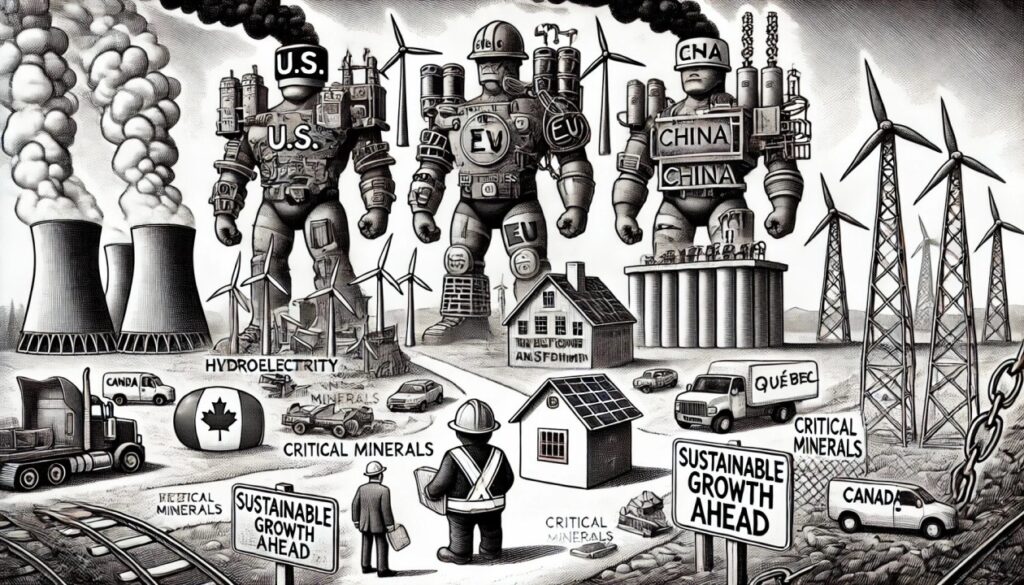
The “America First” trade policy and executive orders recently signed by President Trump present significant challenges for Canada’s energy sector, particularly for Québec. These measures include proposed tariffs on Canadian goods, a divergence in climate policies, and the rollback of electric vehicle (EV) incentives in the U.S. Given the deep integration of the North American auto and energy sectors, these developments have far-reaching implications for Canada’s energy transition.
(LinkedIn: https://www.linkedin.com/pulse/navigating-america-first-strategic-focus-canadas-energy-marcoux-vxmnc/)
Key Challenges
1. Tariffs and Market Competitiveness
The U.S. has proposed a 25% tariff on Canadian goods, including energy exports like oil, natural gas, and hydroelectricity. Québec’s hydroelectric sector, which relies heavily on electricity exports to the U.S., would be directly affected. Such tariffs would undermine Hydro Québec’s competitiveness for long-term contracts and its ability to trade on short-term spot markets in the U.S. Northeast. Canadian oil, already trading at a discount, would face further price pressure, exacerbating financial challenges for oil-producing provinces. This situation also raises questions about the viability of the Keystone XL pipeline, which was promoted by President Trump but may be rendered unnecessary if tariffs further reduce the competitiveness of Canadian oil. This contradiction adds to the uncertainty of future energy investments.
2. Reduced EV Availability
The rollback of U.S. EV incentives and infrastructure programs could hinder the growth of Canada’s EV supply chain. The integration of the North American auto sector means U.S. policies directly influence Canadian markets. A decrease in EV availability in the U.S. could similarly limit their availability in Canada, hindering the adoption of clean transportation technologies and delaying progress toward national emissions reduction targets.
3. Trade Restrictions and Supply Chain Risks
Potential U.S. trade restrictions on imports from countries like China or export controls on critical technologies could delay Canada’s energy transition. Key technologies at risk include:
- Artificial Intelligence (AI): Vital for optimizing energy systems, enabling smart grids, and improving energy efficiency across sectors.
- Energy storage systems: Batteries are essential for renewable energy integration, ensuring grid stability and balancing supply and demand. Advanced systems like lithium-ion and solid-state technologies play a critical role in renewable energy adoption and electric vehicles.
- Grid management software: Necessary for modernizing energy infrastructure.
- Solar and wind components: Turbines, panels, and related systems.
- Transmission and distribution grid equipment: Critical for efficient electricity transmission and grid reliability, particularly with the integration of renewable energy. Transformers are currently in short supply, while DC transmission systems (HVDC) are an expanding market.
If Canada mirrors U.S. restrictions, it could face higher costs and limited access to these critical technologies.
Strategic Responses
Strengthening Domestic Supply Chains
Canada has a much smaller economy than the U.S., the EU, or China. It cannot realistically build supply chains for all components of the energy sector. Governments must focus on critical segments or areas where Canada has a competitive advantage. Key strategies include:
- Re-shoring Manufacturing: Establishing domestic production for segments such as EV batteries, wind turbine components, and transformers to reduce reliance on foreign imports.
- Trade Diversification: Expanding partnerships with Europe, South Korea, and Japan to secure access to essential materials and technologies.
- Critical Material Access: Investing in domestic mining and recycling of rare earth elements and other vital materials.
- Public-Private Partnerships: Supporting innovation and local manufacturing through subsidies and targeted investments.
Examples of focus areas include:
- Critical Minerals: Leveraging Canada’s abundant reserves of lithium, nickel, and cobalt to support battery manufacturing.
- Hydroelectric Power and Energy Storage: Capitalizing on Québec’s hydroelectric capacity, with east-west integration, and integrating advanced energy storage systems.
- Renewable Hydrogen Production: Using renewable energy to produce green hydrogen for industrial decarbonization, particularly in sectors like steel and chemicals.
Prioritizing Local Energy Use
Québec’s abundant hydroelectric resources present an opportunity to focus on local decarbonization rather than exports. Electrification of transportation, heating, and heavy industry within Québec could reduce emissions while insulating the province from volatile export markets.
Similarly, while Canada’s oil and gas sectors warrant support in the near term, governments must balance investments against long-term trends. The International Energy Agency (IEA) predicts a global decline in oil and gas demand as economies transition to net-zero emissions, and China’s consumption of oil likely peaked in 2024. Resources should be prioritized for decarbonization initiatives and the development of clean energy technologies to build long-term economic resilience and adaptability.
Conclusion
The challenges posed by the “America First” trade policy highlight the importance of strategic focus for Canada’s energy transition. By investing in resilient supply chains, emphasizing local energy use, and targeting key sectors where Canada has competitive advantages—such as hydroelectricity, critical minerals, and renewable hydrogen—Canada and Québec can strengthen their energy sectors, enhance economic resilience, and accelerate the transition to a sustainable energy future.